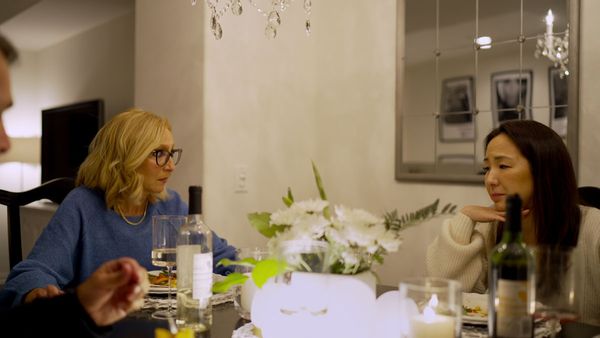Hollywood and cults have a natural affinity for each other. So do cults and social media platforms. Enter “Dancing for the Devil: The 7M TikTok Cult,” the Netflix docuseries bridging the gap between the very online and those of us who primarily watch TV for distraction.
You may not have heard of Miranda and Melanie Wilking, sibling dancers who built a 2 million-strong online following that earned them spots in music videos and endorsement deals.
But you may have noticed Miranda and her husband James “BDash” Derrick dancing in the 2024 version of “Road House,” recognize her from red carpet photos or possibly remember her appearance with other dancers in a 2022 episode of “The Ellen DeGeneres Show.”
Miranda Derrick may be the most visibly famous among the dancers signed to 7M Films, a talent management company founded and run by Robert Shinn, a Los Angeles-based pastor and spiritual leader of Shekinah Church. Other 7M members may be familiar to viewers who watched “World of Dance” and “So You Think You Can Dance,” shows on which several competed before signing with the company.
Vik White, who is allegedly another 7M member, plays one of the heartthrobs in August Moon, the fictional boy band featured in the Nicolas Galitzine-Anne Hathaway romance “The Idea of You.”
None of these are starring roles, but once you’ve watched “Dancing for the Devil” that might change. Unless, that is, you’re already familiar with these faces from your TikTok feed, where they and other 7M dancers churn out videos, moving furiously to excepts of classic pop hits while wearing showy, exaggerated expressions.
Audiences never tire of learning about cults, especially those with entertainment industry ties. Scientology remains this subgenre’s biggest recurring star, even as we seasonally gape at and praise the high-power talent that legitimizes it.
The NXIVM cult only became famous after it was revealed that one of its top lieutenants and first marks was “Smallville” star Allison Mack, who pleaded guilty to racketeering and racketeering conspiracy charges in 2021 and served two years of a three-year prison sentence.
But few cults exist in the Venn diagram overlap between those who mourn the dearth of family-friendly viewing, their TikTok dance-fiending grandchildren and anyone suspicious of charismatic Christian pastors.
“Dancing for the Devil,” directed by Derek Doneen, has something for all those viewers with the bonus of real-time drama.
Audiences never tire of learning about cults, especially those with entertainment industry ties.
By itself this would be considered a smart, all-ages promotional tactic that places them in front of the broadest audience, since TikTok clips are often shared on X, Twitter and elsewhere. But profiles of 7M in The Cut, Rolling Stone, and other outlets dating back to 2022 – and now, Netflix’s series – cast those dance breaks in a sinister light that defies their production polish.
As “Dancing for the Devil” explains, 7M Films began in 2021 when Shinn signed a group of dancers with sizable social media followings struggling to make a living off their craft. The deal he offered was extraordinary – he provided a place for them to live with a low monthly rent, and all they had to do was make dance-oriented social media content, mostly filmed by Shinn’s son Isaiah. That, and attend his church services.
But to Melanie Wilking, the pastor’s demand that they prioritize his word over their lives was suspicious. One of Shinn’s control tactics reportedly requires his followers to “Die to Themselves,” urging them to cut off contact with their families and other loved ones.
This is what Melanie and their parents Kelly and Dean describe in the Feb. 24, 2022, Instagram video where they revealed that Miranda had disappeared from their lives and accused 7M of being a cult.
 Dancing for the Devil: The 7M TikTok Cult (Netflix)
Dancing for the Devil: The 7M TikTok Cult (Netflix)
Several dancers left 7M afterward, and the Wilkings banded together with other parents whose children suddenly disappeared from every part of their lives aside from their public-facing TikTok channels. Many of the subjects featured in the docuseries are plaintiffs in a 2023 civil suit against Shekinah, claiming it is a cult operating under the guise of a religious organization.
Shinn is by no means the first entertainment industry Svengali to profit off other people’s talent and physical labor. Some would say that pretty much describes what an agent does, save for requiring a 10% “Man of God” tip on top of the church tithing and other percentage skims that substantially reduce dancers’ earnings.
Some former 7M members tell their documentary interviewer that sometimes they handed almost everything over to Shinn, even if they didn’t realize they were. All standard operations for cults, confirmed when “Dancing for the Devil” introduces Melanie and Priscylla Lee, two other sisters whose relationship Shinn broke when Shekinah was expressly a worship community.
Melanie Lee left Shekinah and tried to take Priscylla with her, but Priscylla remained under Shinn’s thumb for 21 years. During that time, she alleges he sexually and financially exploited her and other church members by having them work for his various businesses, paying them next to nothing, and exerting control over their bank accounts.
For his part, Shinn’s name is still attached to a number of ventures, and he owns a multimillion-dollar Studio City home where former members say most of the dancers’ video content is shot.
Shinn has denied all wrongdoing and slapped several of those taking legal action against him with countersuits. According to a few of the documentary’s subjects, he also allegedly instructed the dancers to reestablish contact with their families after the Wilkings’ video went viral to maintain the image of normalcy for their social feeds.
People coming into this story fresh from Netflix’s gateway are joining a situation Instagram and TikTok devotees have been following for two years. But considering how microtargeted social media algorithms are, there are many more people in that group than the latter.
 Dancing for the Devil: The 7M TikTok Cult (Netflix)
Dancing for the Devil: The 7M TikTok Cult (Netflix)
This is one of the few cult docuseries that doesn’t require much effort to dig up information on where the main players are. Simply enter a name into any search engine and their video feeds come up.
A major contributor to the 7M cult’s perceived creepiness is the dancers’ unfailing polish and flat if gleaming expressiveness.
The unfailingly flawless choreography, with each dancer hitting their mark perfectly, is amazing in small doses, but to watch several after downloading the documentary is disconcerting. There’s a whole lot of “nothing to see here” distraction — which is the point, and which will continue to build Shinn’s wealth until it collapses. As several experts point out in this and other series, cases brought against alleged cults and their leaders almost always fail unless their members can prove that actual crimes were committed under the auspices of serving the organization.
Dancers tell powerful stories without using words. Ultimately that makes “Dancing for the Devil” a fascinating awakening to the concept of media skepticism.
In the series Melanie Wilking and her parents reveal they have resumed some limited version of contact provided none of them brings up Shekinah or 7M during their visits. One scene shows Melanie weeping at the thought that Miranda, the person she’d always assumed would be at her side on her wedding day, wouldn’t be there. After all, Miranda didn’t tell her family she was marrying BDash; they found out in a TikTok post with the rest of the world.
Right around the time “Dancing for the Devil” premiered, Miranda also posted a stylized photo of herself standing by empty chairs in a courtyard. “Had such a great time at my sister’s wedding,” she posted alongside emojis of sparkles and a ring. There’s a video of Miranda, Melanie and Kelly smiling and dancing together, as if all is mended and there’s nothing to see here.
On June 4, Miranda shared another statement in an Instagram post revealing that she is the plaintiff in a defamation suit and therefore limited in what we could say.
Want a daily wrap-up of all the news and commentary Salon has to offer? Subscribe to our morning newsletter, Crash Course.
Referencing her family, she writes, “The truth is, we just don’t see eye to eye at this time. I believe that this documentary is a one-sided story. I gave my life to Jesus Christ in 2020 and asked my family for some space in the very beginning to collect my thoughts and process my new walk I wanted to take with God . . . My family didn’t honor the space I asked for and I saw a different side to them I’ve never seen before. Honestly, it made me mad, frustrated and annoyed that they were being so overbearing and chaotic.”
Miranda prefaces this written statement with a short video in which she smiles brightly and seems upbeat, waving goodbye as if confirming a coffee date with a friend. Only the people closest to her know if these are her true feelings or if the statement was coerced or written for her.
But fandom is the desired result of a mirage persuading millions that what they see is real and what they hear is the truth. Dancers tell powerful stories without using words. Movement is their language, their medium. Ultimately that makes “Dancing for the Devil” a fascinating awakening to the concept of media skepticism. The 7M dancers are excellent at producing short bursts that strike us with awe but say nothing of note, which we would never question if we didn’t know who is said to be pulling their strings.
“Dancing for the Devil: The 7M TikTok Cult” is streaming on Netflix.
Read more
about this topic

